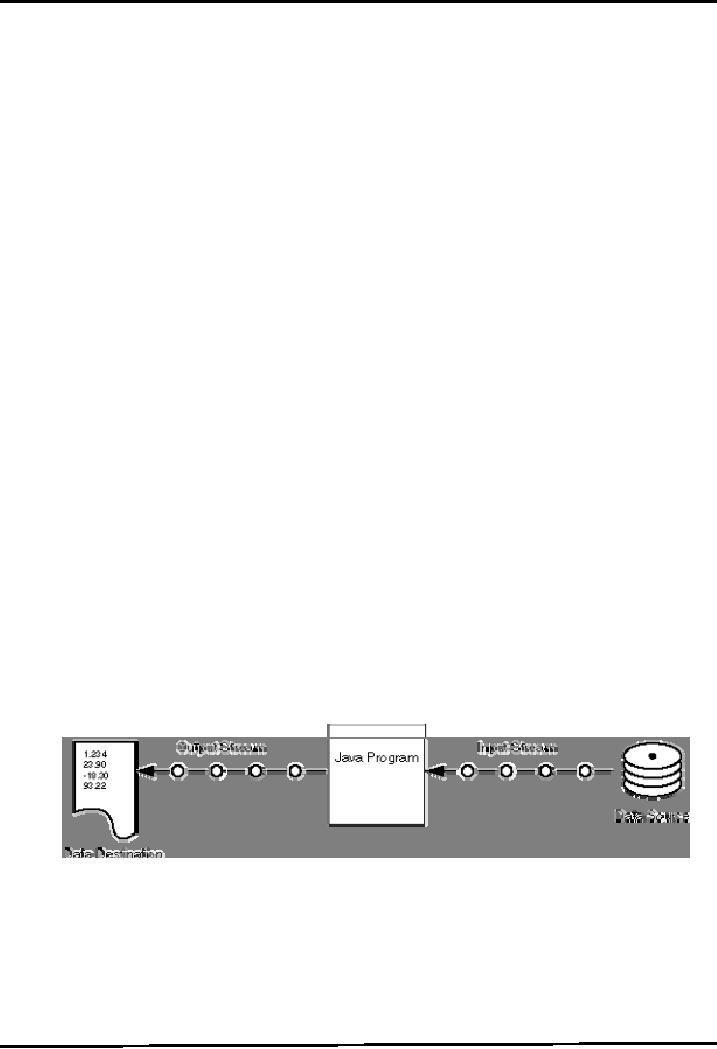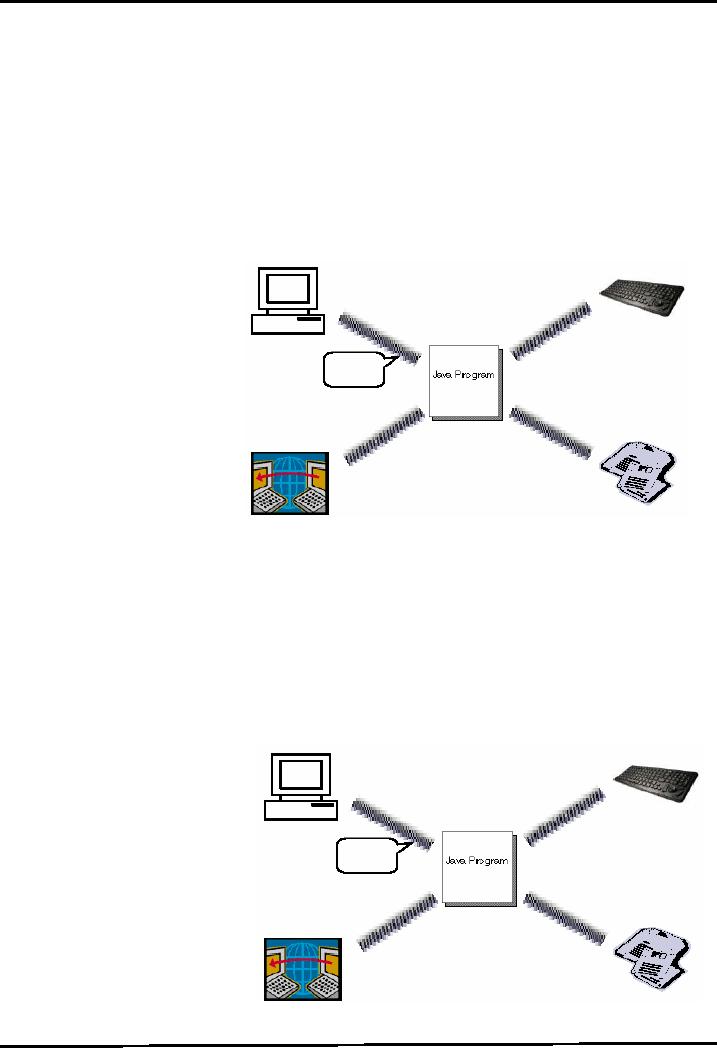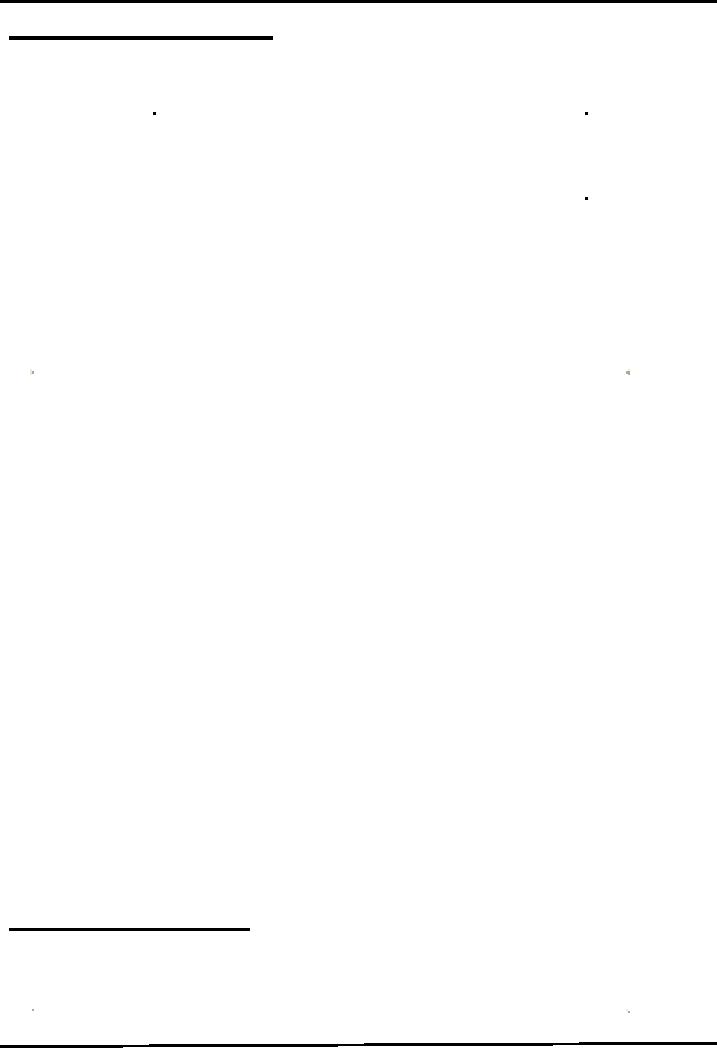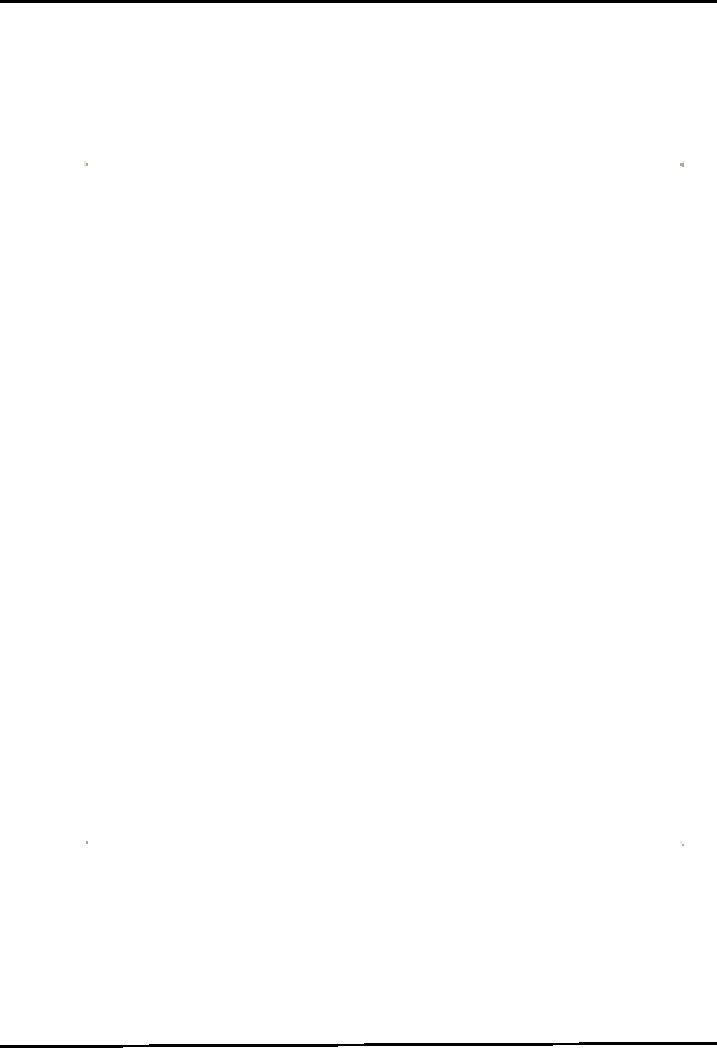 |
JAVA: Streams |
| << JAVA: Intro to Exceptions |
| JAVA: Modification of Address Book Code >> |

Web
Design & Development CS506
VU
Lesson
8
Streams
I/O
libraries often use the
abstraction of a stream,
which represents any data
source or sink as an
object
capable of producing or receiving pieces
of data.
The
Java library classes for
I/O are divided by input and
output. You need to import
java.io package to
use
streams. There is no need to
learn all the streams just
do it on the need basis.
The
concept of "streams"
�
It is an
abstraction of a data source/sink
�
We
need abstraction because there are
lots of different devices (files,
consoles, network,
memory,
etc.). We need to talk to the
devices in different
ways
(sequential,
random access, by lines, etc.)
Streams make the task
easy by acting in the
same
way
for every device. Though
inside handling of devices may be
quite different, yet on
the
surface
everything is similar. You
might read from a file, the
keyboard, memory or
network
connection,
different devices may require
specialization of the basic stream,
but you can
treat them
all as just "streams". When you
read from a network, you do
nothing different
than
when you read from a
local file or from user's
typing
//Reading
from console
BufferedReader
stdin = new BufferedReader(new InputStreamReader(
System.in
));
--------
( your console)
// Reading
from file
BufferedReader
br=new BufferedReader(new
FileReader("input.txt"));
//Reading
from network
BufferedReader br
= new BufferedReader(new InputStreamReader
(s.getInputStream()));
----
"s" is the socket
�
So
you can consider stream as a
data path. Data can flow
through this path in one
direction
between
specified terminal points
(your program and file, console,
socket etc.)
Stream
classification based on
Functionality
Based
on functionality streams can be
categorized as Node Stream and Filter
Stream. Node
Streams
are those which connect
directly with the data
source/sick and provide
basic
functionality
to read/write data from that
source/sink
FileReader
fr = new FileReader("input.txt");
61

Web
Design & Development CS506
VU
You
can see that FileReader is
taking a data/source "input.txt" as
its argument and hence it is
a
node
stream.
FilterStreams
sit on top of a node stream or
chain with other filter
stream and provide
some
additional
functionality e.g. compression, security
etc. FilterStreams take other
stream as their
input.
BufferedReader
bt = new BufferedReader(fr);
BufferedReader
makes the IO efficient (enhances
the functionality) by buffering the
input before
delivering.
And as you can see
that BufferedReader is sitting on
top of a node stream which
is
FileReader.
Stream
classification based on
data
Two
type of classes exists.
Classes
which contain the word
stream in their name are
byte oriented and are
here since JDK1.0.
These
streams
can be used to read/write
data in the form of bytes. Hence classes
with the word stream in
their
name
are byte-oriented in nature. Examples of
byte oriented streams are
FileInputStream,
ObjectOutputStream
etc.
Classes
which contain the word
Reader/Writer are character
oriented and read and write
data in the form of
characters.
Readers and Writers came
with JDK1.1. Examples of Reader/Writers
are FileReader,
PrintWriter
etc
62

Web
Design & Development CS506
VU
Example
Code 8.1: Reading from
File
The
ReadFileEx.java reads text
file line by line and prints
them on console. Before we move on to the
code,
first create a text file
(input.txt)
using notepad and write following
text lines inside
it.
Hello
World
Pakistan is
our homeland
Web
Design and Development
//
File ReadFileEx.java
import
java.io.*;
public
class ReadFileEx {
public
static void main (String
args[ ]) {
FileReader
fr = null;
BufferedReader
br = null;
try
{
// attaching
node stream with data
source
fr =
new FileReader("input.txt");
// attatching
filter stream over node
stream
br =
new BufferedReader(fr);
// reading
first line from
file
String
line = br.readLine();
//
printing and reading remaining
lines
while
(line != null){
System.out.println(line);
line
= br.readLine();
}
//
closing streams
br.close();
fr.close();
}catch(IOException
ioex){
System.out.println(ioex);
}
} //
end main
} //
end class
Example
Code 8.2: Writing to
File
The
WriteFileEx.java writes the strings into
the text file named
"output.txt". If
"output.txt"
file does not exist, the
java will create it for
you.
//
File WriteFileEx.java
import
java.io.*;
63

Web
Design & Development CS506
VU
public
class WriteFileEx {
public
static void main (String
args[ ]) {
FileWriter
fw = null;
PrintWriter
pw = null;
try
{
// attaching
node stream with data
source
// if
file does not exist, it
automatically creates it
fw =
new FileWriter
("output.txt");
// attatching
filter stream over node
stream
pw =
new PrintWriter(fw);
String
s1 = "Hello World";
String
s2 = "Web Design and
Development";
//
writing first string to
file
pw.println(s1);
//
writing second string to
file
pw.println(s2);
//
flushing stream
pw.flush();
//
closing streams
pw.close();
fw.close();
}catch(IOException
ioex){
System.out.println(ioex);
}
} //
end main
} //
end class
After
executing the program, check the
output.txt file. Two lines
will be written there.
Reference
Example
code, their explanations and
corresponding figures for this
handout are taken from the
book
JAVA A
Lab Course by Umair Javed.
This material is available
just for the use of VU
students of the
course
Web Design and Development and
not for any other commercial
purpose without the consent
of
author.
64
Table of Contents:
- JAVA FEATURES
- Java Virtual Machine & Runtime Environment
- Learning Basics of JAVA
- JAVA: Object Oriented Programming
- JAVA: Inheritance
- JAVA: Collections
- JAVA: Intro to Exceptions
- JAVA: Streams
- JAVA: Modification of Address Book Code
- JAVA: Graphical User Interfaces
- JAVA: Event Handling
- JAVA: More Examples of Handling Events
- JAVA: Problem in Last Code Example
- Java Database Connectivity
- JAVA: More on JDBC
- JAVA: Result Set
- JAVA: Meta Data
- Java Graphics
- JAVA: How to Animate
- JAVA Applets
- JAVA: Socket Programming
- JAVA: Serialization
- JAVA: Multithreading 1
- JAVA: Multithreading 2
- JAVA Web Application Development
- Java Servlets
- JAVA: Creating a Simple Web Application in Tomcat
- JAVA: Servlets Lifecycle
- JAVA: More on Servlets
- JAVA: Dispatching Requests
- JAVA: Session Tracking 1
- JAVA: Session Tracking 2
- JAVA: AddressBook Case Study Using Sevlets
- Java Server Pages 1
- JavaServer Pages 2
- Java Server Pages 3
- JAVA: JSP Action Elements and Scope
- JAVA: JSP Custom Tags
- JAVA: MVC + Case Study
- JAVA: MVC Model 2 Architecture
- JAVA: Layers and Tiers
- JAVA: Expression Language
- JAVA: JavaServer Pages Standard Tag Library (JSTL)
- JAVA: Client Side Validation & JavaServer Faces (JSF)
- JAVA: JavaServer Faces